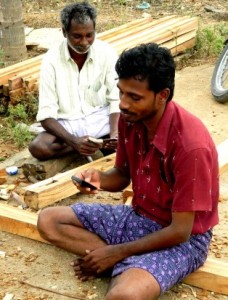Why Mobile Wallets Won’t Work in India… Yet: The need is there, but obstacles remain
As you might expect, India has more competing mobile network operators (12) than any other country and is only slightly behind China for subscribers (around 894 million). It is widely acknowledged as the fastest growing mobile market in the world.
India is also acknowledged as one of the most problematic countries anywhere for financial inclusion, particularly in the roughly 600,000 rural villages which have only about 33,500 commercial and regional rural banks—or one bank branch per 14,000 customers. The Reserve Bank of India (RBI) data confirms that more than 145 million families, close to half the population, have no access to formal banking services.
The solution seems obvious. The mobile operators, especially the top three (Airtel, Reliance and Vodafone, each with a healthy respective market share of over 20 percent), should provide mobile wallets and banking to the more than half billion who have no account, or only frustrating and limited access to local bank branches.
In addition to enabling more and better savings, credit, electronic money transfers and payments, mobile wallets can also help operators reduce customer churn rate (every network’s worst fear in a highly competitive market) – plus the new m-wallet/banking marketing campaigns for these low-income targets can boost overall financial capability. (Please see MicroSave’s recent blog on rethinking financial education and a note on marketing lessons).
Everyone benefits. But in India, nothing is simple.
The first problem, no surprise, is regulatory red tape and long delays. “Open” mobile wallets—i.e. not sponsored directly by a bank—all need to be linked to a bank account anyway. (For more on India’s bank-led financial inclusion model, and the unhappy symbiosis between banks and telecoms in general, please see MicroSave’s recent blog, Why is the Chicken Afraid to Cross the Road?)
 And bank accounts don’t happen for wallets without a comprehensive authentication–Know Your Customer (KYC)–process. Most bank branches have figured out ways to streamline KYC for a normal or no-frills account to one or two days. Mobile operators can have your new phone ready to use in less than 24 hours. In highly competitive markets, the process is even faster. But wallets are a new and uncertain hybrid that no one fully trusts yet—and authentication turnaround time of up to two weeks does nothing to help inspire greater confidence.
And bank accounts don’t happen for wallets without a comprehensive authentication–Know Your Customer (KYC)–process. Most bank branches have figured out ways to streamline KYC for a normal or no-frills account to one or two days. Mobile operators can have your new phone ready to use in less than 24 hours. In highly competitive markets, the process is even faster. But wallets are a new and uncertain hybrid that no one fully trusts yet—and authentication turnaround time of up to two weeks does nothing to help inspire greater confidence.
MicroSave’s on-site observations for a leading mobile operator indicate preliminary paperwork is probably the first and worst hurdle to clear. Prospective wallet customers do not fill out (or have help filling out) their application forms in a bank branch under the watchful eye of a teller. Forms are completed in the busy local shops of bank agents. Many applicants are illiterate and, as one researcher explains, “The agent instructs them to either sign or put thumb impressions in the requisite places of the account-opening form. And the rest of the form is filled in either by the agent, other staff or super agent [regional network manager]—or, in several cases, by no one.”
Business correspondents (BCs) receive commissions on the number of new accounts they activate, not on the number of mistakes and incomplete answers they catch on the forms. So the banks return the forms as invalid, the forms wait around in the agents’ shops for the prospective wallet customers to return, and the KYC process begins anew. (Or the invalid forms get lost somewhere en route, and/or BCs have no way of tracking down the applicant.) A two-week turnaround time begins to make more sense.
Another complication are the various cross-platform audits and hierarchies which include agents, super agents (BC network managers), bank managers, mobile network managers…and then back down the chain to the prospective customer. Rural India is not renowned for instant and highly efficient delivery systems, but the impressive surge in internal remittances in many regions has increased everyone’s expectations and demands for speedier processing and problem resolution.
Possible solutions to these complications include:
- Better agent training for these applications
- Closer monitoring by their managers for accuracy and completion
- Incentives for precision and correct fulfilment, in addition to the new-account catalysts
- Daily electronic updates for the mobile network operators’ wallet sponsors on their applications’ progress or lack thereof (on the premise that the operators care a lot more than the banks whether these wallets actually materialize or not)
Ultimately, new ideas like mobile wallets work because they fulfill a need. The need is clearly there for many in India—with and without access to banking services—but any new idea involving money has to work perfectly and inspire full trust before anyone will adopt it. Mobile wallets have more to address than simply increased marketing and advertising to succeed with the many customers who need what they are selling.
Editor’s note: this post was originally published on MicroSave’s blog. It is cross-posted with permission.
Ritesh Dhawan is an analyst in MicroSave’s Digital Financial Services Domain.
- Categories
- Uncategorized

